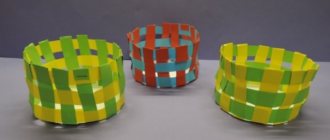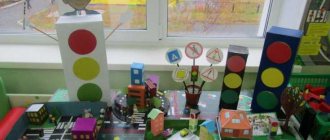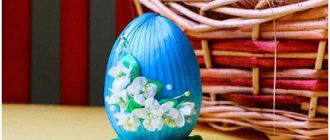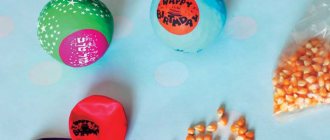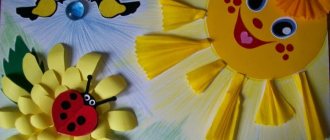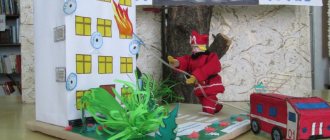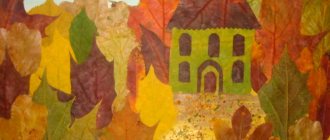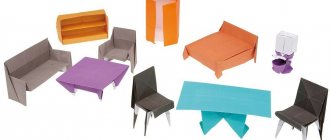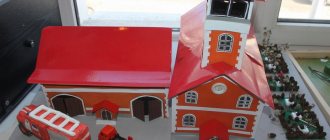Regular sports activities are the key to human health. Many people develop a variety of chronic diseases due to an inactive lifestyle. As a result, a love for sports should be instilled from early childhood.
In order to promote an active lifestyle, various holidays are organized (for example, Sportsman's Day). In addition, craft competitions on the theme “Sports” are regularly held for kindergarten.
Where does the making of a craft begin?
Initially, you need to decide on the level of complexity of working on a children’s craft and its theme. Children of early preschool age can:
- bring an original drawing;
- make an applique;
- make a craft on the theme “Sports” from plasticine.
At older ages, children are able to perform more complex tasks. For example, they can make a three-dimensional model of a sports ground.
When making crafts, one should not forget that this task was given specifically to the child. Therefore, parents need to take minimal participation in its production. Working on a craft is a creative process.
Therefore, you should not deprive your child of the opportunity to realize his own fantasies. Let him figure out what the craft should look like. Parents just need a little help in making the layout.
Ant-athletes made from walnuts
For this craft you will definitely need:
- Walnuts (in shell);
- Pieces of soft wire;
- Liquid nails with a gun;
- Plasticine;
- Several beads, depending on the planned number of athletes.
Completing of the work:
- 3 nuts in the shell are fastened together. Thus, the body of an ant is made. The beads will become his eyes, the mouth can be cut out of paper, and the elements of the laces can be his antennae.
- Take identical pieces of wire 3-4 cm long - these will be the upper and lower legs of the ant. They will be attached to the body with glue. The ends of the paws can be made from plasticine.
- By adding various elements to the resulting ants, they can turn into various athletes. You can make boxing gloves from pieces of plasticine. Using a piece of wire, thread and a toothpick, you can turn one of the ants into an archer. If you have popsicle sticks, you may well end up as a skier. An important addition to the composition will be an ordinary shoe box depicting an entire sports arena. Spectators can be painted on its inside walls.
What material can be used?
As a rule, crafts are made from available materials at home. Some people prefer to purchase ready-made art kits. But the cost of such goods is quite high.
Therefore, it is worth paying close attention to inexpensive materials for crafts on the theme “Sports” for a master class. After all, they can easily find a non-standard way to use them.
DIY crafts on the theme “Sports” include:
- using cotton wool to make snow;
- use of white glitter. With their help, snow with beautiful tints is obtained;
- use of dense polyethylene. Ice is made from this material.
Plasticine is a flexible, soft material that is often used to make crafts. Making a soccer ball is considered the easiest task. It does not require any special skills.
The dark colored sandpaper is very reminiscent of a stadium running surface. An ordinary dishwashing sponge perfectly imitates a sports mat. A thin cocktail tube can become the basis for any complex design. In turn, roll sticks can easily be turned into parallel bars for gymnastics.
It should be remembered that all materials used to make crafts must be durable, with a securely fixed structure. After all, the model still needs to be transported to its destination.
Crafts on sports themes from scrap materials
Scrap materials are the most accessible, in-demand, varied materials for creating crafts, especially on a sports theme, be it a winter sport or team games.
With a little imagination, you can create whatever you want.
Perhaps one of the good options is to create a pet, a symbol of the Olympic Games - the Olympic Bear! This hero is liked not only by children, but also by adults.
To create it you will need:
- lid from a box of chocolates;
- disposable rectangular tray (it is used in stores for packaging cookies and fruits);
- packaging of cotton swabs;
- silver cardboard;
- a little plasticine (red and black);
- knitting threads (colors: red, yellow, black, blue, green);
- 5 pieces of small rings made of cardboard or thin foam;
- scissors;
- glue;
- Olympic bear print.
First you need to cut out the outline of the bear. Cut the cotton swabs, for the craft you need only those parts where the cotton is located, the sticks themselves are not useful. Glue the required size of silver cardboard into the lid under the candies. Glue the bear blank onto it. Glue cut cotton swabs along the silhouette of the bear. Press well and let dry a little. Form eyes, a nose, a mouth, and claws from plasticine and glue them with glue.
Make holes in the disposable pallet so that the edge of the box can be placed so that the finished panel can stand practically. Wrap the ring blanks with knitting threads, secure this symbolism of the Olympic Games on the pallet in front of the bear (you can glue it or make holes and secure it well with threads). Such a sweet, soulful craft will delight everyone.
As a material for sports crafts, you can use everyone’s favorite candies. You can quickly and easily form a soccer ball from them; you don’t need a lot of effort and time to create it. All you have to do is take a round ball (you can make it out of paper, or take a tennis ball) and completely cover it with candy. It is desirable that the candies have black and white wrappers, then the ball will look more like a football.
You can also use other available materials for such crafts: disposable tableware, old unnecessary light bulbs, paper napkins, buttons, beads...
Creating sports-themed crafts is a good, exciting activity that stimulates the desire to take up some kind of sport and lead a healthy lifestyle. After all, with the help of such an activity, you can immerse yourself in the sports world and learn its intricacies. A sports theme for crafts is one of the best themes for such an activity!
Making an applique
You can simply cut out a variety of sports equipment. Kettlebells, balls, and dumbbells are ideal for this purpose. Then the child needs to independently arrange such shells on paper. You can also draw a football field on a landscape sheet or print out small figures of athletes. And the kid will independently distribute the members of the football team on the field.
You can also depict your favorite cartoon characters who are actively involved in sports. Even a very small child can cut out Smeshariki figures from paper. Applications featuring these characters are an excellent option for crafts for kindergarten.
What might you need when working with the application?
To make an applique, you should arm yourself with:
- a set of colored paper;
- scissors;
- white cardboard;
- glue;
- box of colored pencils.
Origami
Origami is a type of craft made from folded paper. This type of activity appeals to children of all ages, as well as adults. On such an interesting topic as sports, there are a lot of ideas, instructions, video lessons for such an interesting craft technique. For such art you need to stock up on patience, concentration, paper and of course time. This activity takes a lot of effort and time, but the result is worth it.
Origami with a sports theme is one of the new popular types of crafts. Here both children and adults can show their skills and talent. The most popular ideas on the topic of sports are origami balls (soccer, basketball, volleyball), figure skating skates, boxing gloves.
Applique with swimmers
Cardboard is used as a basis for appliqué. It is on this that all the necessary parts are glued. First you need to take blue colored paper. Then it needs to be cut into long uneven strips (they will represent the water in the pool). After this, the swimmers are cut out. Their face will be a white circle, their body will be a small rectangle of any color, and their arms will be white stripes.
Most of the cardboard is sealed with blue stripes. The existing swimmers are carefully glued on top of them. A judge and spectators are depicted on a blank piece of cardboard.
Such an application involves the child using several performance techniques at once. It is quite simple: the implementation of such an idea does not involve any difficulties.
Sports ball
To make crafts you should use:
- white threads;
- PVA glue;
- balloon;
- a set of paints.
First you need to inflate the balloon. After this, it is wrapped with a large number of threads, the craft is treated with glue, and wait until it dries completely. The balloon is then deflated. As a result, only a frame made of thread remains.
After this, the ball must be colored in accordance with the desired sport. The volleyball ball is decorated with blue and yellow stripes, the soccer ball is decorated with black slots. When making a volleyball you will need orange threads and black stripes.
From the experience of a preschool teacher on the topic: Healthy lifestyle
Innovative technologies in solving health problems of children of primary preschool age.”
Description of the material: I offer you a workshop on health-improving work with preschool children. The development will be of interest to educators, preschool physical development instructors, and parents of preschool children. “To make a child smart and sensible, make him strong and healthy: let him work, act, run, scream, let him be in constant motion.”
In accordance with the Law “On Education”, children’s health is one of the priority areas of state policy in the field of education.
What is health? In the “Dictionary of the Russian Language” by S.I. Ozhegova: “ Health is the correct, normal activity of the body.” The Constitution of the World Health Organization (WHO) states that health is not only the absence of disease or infirmity, but also complete physical, mental and social well-being. Children's health is one of the pressing problems of our time, in particular for preschool institutions. An analysis of the health status of preschool children in the Russian Federation shows that over the last decade the number of absolutely healthy children has decreased from 23 to 15% and the number of children with chronic diseases has increased from 16 to 17.3%. On average in Russia, every preschooler experiences at least two diseases per year. Approximately 20 - 27% of children fall into the category of frequently and long-term illnesses. Almost 90% of preschool children have standard deviations in the structure of the musculoskeletal system - poor posture, flat feet, unbalanced muscle tone, etc. According to forecasts, 85% of these children are potential patients with cardiovascular diseases. About 50% of children need psychocorrection and are characterized by serious psychological distress. The presented results clearly indicate the socio-pedagogical level of problems that arise before employees of preschool institutions, called upon to raise a healthy child with optimal physical and mental development, which corresponds to the social demand of society. Preschool age is a decisive stage in the formation of the foundation of a child’s physical and mental health. During this period, there is intensive development of organs and the formation of functional systems of the body. The steady trend of deterioration in the health of preschool children that has emerged in recent years, an increase in the number of children with mental and speech development disorders, dictates the need to search for mechanisms to change this situation. The main task of a kindergarten is to prepare a child for an independent life, giving him the necessary skills, skills, and developing certain habits. There are many different non-drug methods of influencing the body in order to improve its health and support, which can be used in a kindergarten. That is why health-saving educational technologies have become in demand by teachers of educational institutions. Health-saving educational technology is a systematically organized set of programs, techniques, methods of organizing the educational process that does not harm the health of children; qualitative characteristics of educational technologies based on the criterion of their impact on the health of students and teachers; technological basis of health-saving pedagogy. Health-saving technology is a system of measures that includes the interrelation and interaction of all factors of the educational environment aimed at preserving the health of the child at all stages of his learning and development). The goal of health-saving technology is: to provide a preschooler with a high level of real health, equipping him with the necessary knowledge, skills, and abilities necessary to lead a healthy lifestyle, and cultivating in him a culture of health. Many tasks that the teacher solves in the process of his activities are subordinated to the solution of this goal. Teachers in kindergartens teach children a culture of health, how to take care of their bodies, that is, a conscious attitude towards their health and safe behavior. Objectives of health-saving technology: 1.Teach children safe behavior in emergency situations in nature and the metropolis. 2. To unite the efforts of employees and parents for the effective organization of physical education and health work, including the prevention of flat feet and posture disorders. 3. To ensure continuity between the preschool educational institution and the school by means of physical education and recreational work. What tasks do we face to strengthen our health and the health of our students? I will highlight the main ones: -maintain health, both physical and mental; - create a pedagogical and protective daily routine in the kindergarten, the main task of which is constant concern for improving the health of children and employees; - teach children specific techniques that strengthen their health, in which the most important is physical education activities; - create a favorable psychological climate, an atmosphere of goodwill and trust between children, employees and parents; -search for new innovative physical education and health forms of work. Our team began to ensure the effectiveness of these tasks by creating conditions. After all, the effectiveness of physical education and health work depends on the reasonable organization of the developmental environment, which is maximally focused on the interests of the preschooler and strengthening his health. Each group is equipped with “Health Corners”. They are equipped with both traditional aids (massage mats, sports equipment, etc.) and non-standard equipment. All equipment is created taking into account aesthetics, dynamism, the age of children, and contributes to the development of motor creativity. Unusual equipment, a combination of traditional and innovative, develops in children an increased interest and desire to engage in physical education, stimulates their motor creativity, and improves their emotional state. In our group (children aged 4-5 years), health work is carried out constantly and systematically. All health-improving activities are built in a sequential chain and evenly distributed throughout the day in the form of a “Path of Health”: “PATHWAY OF HEALTH” (health-improving activities during the day): MORNING
1. Morning exercises 2. Finger exercises 3. Game massage 4. Hand washing and faces with cold water 5. Health games 6. Breathing exercises 7. Music therapy
ACTIVITY
1. Before class - play massage;
kinesiological gymnastics 2. Dynamic pause, physical exercises in class 3. Logorhythmic exercises 4. Gymnastics for the eyes WALK
1. Motor activity (running, games, exercises) 2. Outdoor play 3. Breathing exercises
BEFORE BED
1. Corrective paths (prevention of flat feet) 2 .Finger gymnastics 3. Chewing gymnastics 4. Music therapy (While eating) 5. Relaxation 6. Aerophytotherapy AFTER
AWAKENING
1. Gymnastics - awakening (in bed) 2. Corrective paths (prevention of flat feet) 3. Hardening measures (barefoot, contrast - air baths, water, snow)
AFTERNOON SNACK
1. Psycho-gymnastics (emotional health) 2. Posture (prevention of scoliosis)
EVENING
1. Finger games 2. Music therapy I use a lot of interesting non-traditional and developmental forms of healing in my work with children (finger gymnastics, gymnastics for the eyes, breathing exercises, outdoor games, exercises for relaxation and correct posture, facial warm-ups, acupressure, preventive exercises for the nasopharynx, etc.). I recommend these forms of work to my teachers, who conduct them in classes of all types of activities, walks in the form of motor minutes.
Technologies for preserving and stimulating health:
Dynamic pauses - during classes, 2-5 minutes, as children get tired. Recommended for all children as a preventive measure against fatigue. May include elements of eye gymnastics, breathing exercises and others, depending on the type of activity. Systematic use leads to an improvement in the psycho-emotional state, a change in attitude towards oneself and one’s health. Health-improving games - as part of morning exercises, on a walk, in a group room - low, medium and high degrees of mobility. Daily for all age groups. Games are selected according to the age of the child, the place and time of the game. Games are designed to prevent fatigue caused by intense intellectual stress. In addition to relaxation, they perform communicative, entertaining and educational functions (games by A.S. Galanov “Musicians”, “The Ball Burst”, “Airplane - Airplane”; Alyamovskaya V.G., Petrova S.N. “Ears”). Finger gymnastics – from a young age, individually or with a subgroup daily. Recommended for all children, especially those with speech problems. It is carried out at any convenient period of time (at any convenient time) (“Finger games” by L. Savina, E. Belaya, Tsyntarny game “Finger on finger – knock – knock – knock...”, “Friendship”). Game self-massage (massage of biologically active points (BAP), hand massage, massage of magic points of the ears, acupressure, intellectual massage of Fritz Auglin, anti-stress massage, massage with the help of su-jok, plastic clothespins) - these are the first elements of self-help for your body, they are taught consciously take care of your health and are the prevention of colds, increasing tone. It is carried out at the beginning of the lesson, because requires attention, creates a positive emotional mood for further activities. Duration - _ _ daily for 3-5 minutes at any free time, depending on the intensity of visual load from a young age. It is recommended to use visual material, demonstration by the teacher (“Sunny Bunny”, “Treat for the Sick”) Breathing gymnastics - in various forms of physical education and recreational work .Ensure the room is ventilated, the teacher gives instructions to the children about mandatory hygiene of the nasal cavity before the procedure.With the help of proper breathing, you can avoid sinusitis, asthma, neuroses, get rid of headaches, runny nose, colds, digestive and sleep disorders and quickly restore performance after mental and physical fatigue (sets of exercises by A.N. Strelnikova “Warm-up”, “Bends”, “Pendulum”, B. Tolkachev “Samovarchik”, M. Lazarev “Mosquito”, “Bug”, tempering breathing (application). Corrective gymnastics - in various forms of physical education and health work. The form of implementation depends on the task and the number of children. Orthopedic gymnastics – in various forms of physical education and health work. Recommended for children with flat feet and as a preventive measure for diseases of the supporting arch of the foot/ Chewing exercises - performed before meals in order to activate the organs involved in eating (oral cavity, internal organs) (application) Logorhythmics is an active therapy based on a system of physical exercises , which is based on the connection between word (speech), music and movement. The goal of logorhythmics is to overcome speech disorders through development. education and correction of children with speech pathology of the motor sphere in combination with words and music. Logorhythmics objectives:
- health-improving (strengthening the musculoskeletal system, developing breathing, motor skills);
-educational (formation of motor skills and abilities, spatial concepts); -educational (education and development of a sense of rhythm, the ability to perceive musical imagery); -corrective (correction of a certain disorder at a certain age). (I include in my work the games of S. and E. Zheleznov, musical dynamic games with movement by T.A. Lobanova - “Warming” and others) Kinesiological gymnastics I’ll tell you a little about the kinesiological gymnastics carried out with children. Currently, the number of children with minimal brain dysfunctions (30% of the total number), which are manifested by speech and thinking disorders, and mental changes, is growing. It has been proven that disturbances in the functional asymmetry of the cerebral cortex and interhemispheric interaction play a certain role in their occurrence. Hardly 10% of people on earth use both hemispheres of their brain in a balanced manner. The rest develop only the left hemisphere and ignore the colossal creative potential of the right. In order to CREATIVELY comprehend any problem, both hemispheres are needed: the left hemisphere, the logical one, highlights the most important, key points in each problem, and the right hemisphere, the creative one, grasps it as a whole. Kinesiology is the science of brain development through movement. It has been around for two hundred years and is used all over the world. Kinesiological exercises develop the corpus callosum, increase stress resistance, synchronize the work of the hemispheres, improve mental activity, help improve memory and attention, and facilitate the process of reading and writing. (We use the following exercises for working with children: “We’ll rub our ears hard...”, “Ring”, “We’ll make a necklace. We’ll give it to mom”, etc.) Relaxation - in any suitable room, depending on the condition of the children and goals, teacher determines the intensity of technology.
For all age groups. You can use calm classical music (Tchaikovsky, Rachmaninov), sounds of nature. Our music library has special music for relaxation. Relaxation is often accompanied by artistic expression. Corrective technologies
Psychogymnastics. A calm state of the nervous system returns the child to health. (studies by M. Chistyakova) Technologies of musical influence - in various forms of physical education and health work; or separate classes 2-4 times a month, depending on your goals. Used as an aid as part of other technologies; to relieve tension, increase emotional mood, etc. Color influence technologies – Correctly selected interior colors in our group relieve tension and increase the child’s emotional mood. Aerophytotherapy is a method of preventing respiratory diseases. Only natural oils have aromatherapy properties. Aroma lamps can be used. Smelling bottles, inhalers, herbal pads (attachment: list of recommended oils). We use a spray bottle or moisten a paper napkin and place it on the battery. In the process of work, material on the use of health-saving technologies has been collected, card files of games and exercises have been developed, and instructions for parents have been compiled. Conclusion: So, let's make brief conclusions from all of the above.
The use of health-saving technologies in the upbringing and development of children gives positive results. Children adapt faster to the subject-spatial environment, to peers and adults: their body's resistance to colds and physical activity increases. I would also like to note the improvement in social health indicators. I think that educators and medical workers will agree that the problem of children’s health is not a matter of one day and the activity of one person, but the focused, systematic work of the entire team of the group and the kindergarten as a whole. This is the process of raising and educating preschool children in a health-preserving and health-enhancing mode; a process aimed at ensuring the physical, mental and social well-being of children over a long period. It is worth noting that only constant and focused work will give progressive results. These are not all innovative approaches to organizing physical education and health work to preserve and strengthen the health of children; each of you can continue and multiply them. APPENDIX
“Chewing gymnastics” complex: 1. “Warm the tummy” - stroke the tummy clockwise 10 times. 2. “Click your teeth” - open and close your mouth 24 times. 3. “Stretch” - clasp your hands above your head, stretch upward 1 time. 4. “Stroke it with the tongue” - massage the palate with the tongue clockwise 1 time; counterclockwise 1 time, swallowing saliva deeply. 5. “It smells so delicious!” - sit down at the tables and smell the food. ! We perform exercises No. 1, 2, 3, 4 while standing, not far from the set tables. Intellectual massage (Fritz Augli, Swiss child psychologist, professor) 1. Pull your ears forward and back, count to ten, start with your eyes open, then with your eyes closed. 2. Massage the cheeks using circular movements of the fingers. 3. Massage the forehead and chin with circular movements, as if drawing circles. 4. Eyelid massage. We fold our fingers with scissors and massage the upper and lower eyelids without closing the eyes. 5. Nose massage. Using the pads of your index fingers, press from the bridge of your nose to the wings of your nose. 6. Movement of the jaw from left to right and vice versa. Anti-stress massage 1. Massage of the fingers: a) press on the phalanx of the fingers, top - bottom, right - left; b) massage each finger with circular movements and movements from top to bottom. 2. Massage the wrist with circular movements. 3. Hand massage. Exercises: “washing your hands,” rubbing your palms and “warming your cheeks.” 4. Forehead massage. Using your fingertips from the middle of the forehead, stroke the forehead, cheeks, neck and reset. 5. Shoulder massage. Pinching of the shoulders from the neck down. 6. Nape massage. Using your index fingers, massage from bottom to top and release. 7. Neck massage. With both hands, massage the neck from the spine from bottom to top and release. 8. Head massage. Above the ears to the upper ear cup, from the forehead to the upper ear cup. 9. Ear massage. Pinch the ear from top to bottom and reset. 10. Ear massage, headphones. Hardening breathing This type of hardening strengthens the entire respiratory tract. Its essence lies in performing a set of game exercises with the nose. Recommended for younger children, but can also be used with older children. It is carried out 2–3 times a day. “Let's play with the nose” I. Organizational moment. “Find and show your nose.” Children sit comfortably and show their nose to an adult. II. Main part. Playful exercises with your nose: “Help your nose get ready for a walk.” Each child takes a handkerchief or napkin and carefully cleans his nose independently or with the help of an adult. “The nose is walking.” An adult invites children to close their mouth tightly so that it does not interfere with walking and breathing well through their nose. Older children can be asked to turn off mouth breathing by pressing the tip of their tongue to the hard palate. In both cases, inhalation and exhalation are performed through the nose. “The nose is playing around.” While inhaling, the child resists the air by pressing the thumb and forefinger of one hand on the wings of the nose. “The nose smells a pleasant smell.” The child performs 10 inhalations and exhalations through the right and left nostrils, alternately closing them with the index finger. "The nose sings a song." As you exhale, the baby taps the wings of his nose with his index finger and sings: “Ba-bo-boo.” “Let’s warm up our nose.” The child places his index fingers on the bridge of his nose and moves them towards the wings of the nose, then up and back. This is how rubbing is done. III. The final stage. The nose is returning home.” Children put away scarves and napkins. Show an adult that their nose is back. Note: Game exercises can be accompanied by poems: Come to me, my friend, And quickly sit in a circle. Find your nose quickly and show it to Aunt ____________. You need to clean your nose and pack it up for a walk. Close your mouth, just walk with your nose. What a pampered nose! He's used to playing pranks with us. Hush, hush, take your time, breathe in the aroma. It’s good to walk in the garden and your nose sings: “Ba-bo-boo.” We need to warm up our nose and rub it a little. My nose has had a walk and is returning home. Hand massage Intense pressure on the fingertips stimulates blood flow to the hands. This promotes psycho-emotional stability and physical health, increases the functional activity of the brain, and tones the entire body. “Let's play with pens” I. Preparatory stage. Children rub their palms until they feel pleasantly warm. II. Main part. 1. Massage with the thumb and forefinger of one hand - rub each finger, starting from the nail phalanx of the little finger of the other hand. 2. Massage the backs of your hands, imitating hand washing. 3. Interlace the extended fingers of both hands and lightly rub them against each other, pointing the palms in opposite directions. 4. We close the intertwined fingers and bring them to the chest. Pause. 5. We stretch our fingers up and move them. III. The final stage. Children shake their hands, relax them and rest. Note: The exercise can be accompanied by verses: Hey guys, everyone is coming to me. Who is standing there on the sidelines? Come on, quickly get inspired and start the massage game. I’ll rub my palms hard, I’ll twist each finger. I'll say hello to everyone, I won't bypass anyone. I'll play with my nails and rub them against each other. Then I’ll warm up my arms and gently stretch my shoulders. Then I’ll wash my hands, I’ll put them finger to finger, I’ll lock them and keep them warm. I'll stretch out my fingers and let them run like bunnies. One-two, one-two, The game is over. The game is over, the kids are resting. Massage of the magic points of the ears. This type of hardening is based on stimulation of biologically active points located on the auricle and reflexively connected with almost all organs of the body. Massaging these points is useful, in particular, for improving the functioning of the respiratory system and protecting the body from colds. Is accessible to children of all ages. It is recommended to do it in a playful way 2-3 times a day. “Let's play with the ears” I. Organizational moment. The teacher attracts children to the game and gathers them in a circle. II. Main part. Exercises with ears. “We’ll find and show you the ears.” Children find their ears and show them to an adult (if their hair gets in the way, they are pinned at the top). “Let’s clap our ears.” The child puts his palms behind his ears and bends them forward, first with the little finger, and then with all the other fingers. Pressing his ears to his head, he suddenly releases them. In this case, the child should feel cotton. “Let’s pull our ears.” The baby grabs the earlobes with the tips of his thumb and index finger, pulls them down with force, and then lets go. “Let’s twist the trestle.” The child inserts his thumb into the external auditory opening, and with his index finger presses the tragus - the protrusion of the auricle in front. Having thus grabbed the tragus, he squeezes and turns it in all directions for 20–30 seconds. “Let’s warm our ears.” The child puts his palms to his ears and carefully rubs the entire shell with them. III. The final stage. Children relax and listen to silence. Note: The number of repetitions of each exercise depends on the age of the children. On average, this is 7–8 times; for children, 5–6 times are enough. Actions can be accompanied by poems: Come to me, my friend, And quickly sit in a circle. Find your ears and show them quickly. We play cleverly with them. We flap our ears like this. And now we are pulling everything down. Ear, don't fall off! And then, and then They twisted the tragus. The ear seems to be frozen, this is how you can warm it up. One, two! One, two! So the game is over. And once the game ended, it was quiet! Aerophytotherapy. For diseases of the respiratory tract in the acute period and during their chronic course, the following essential oils are recommended: - anise - angelica - oregano - hyssop - camphor - European cedar - peppermint - rosemary - chamomile - tea tree - fennel - sage - eucalyptus During the rehabilitation period after illnesses diseases, in stressful situations (adaptation to preschool education) essential oils are indicated that have a relaxing, calming effect: - basil - valerian - angelica - oregano - lavender - marjoram - lemon balm - mimosa - spearmint - rosemary - dill
We recommend watching:
Hobbies of a kindergarten teacher Features of creating a culture of safety in preschoolers Development of color perception in preschool children Development of mental abilities of preschoolers through children's literature
Similar articles:
Surprising moments in kindergarten classes. Card index
Kindergarten teacher business card
Presentation of kindergarten for parents
Morning exercises in kindergarten in the preparatory group
Features of outdoor games with preschool children
Competition figurine
Making such figures is a fairly easy option. The easiest way is to take a doll and add the appropriate attributes. If you make a swimsuit out of a balloon for the toy and put a ribbon in her hand, Barbie will turn into an elegant gymnast. A small teddy bear can be dressed in a kimono.
Note! You can also use existing mascots at sporting competitions. Everyone knows what symbols were used during the Winter Olympic Games held in Sochi.
Simple crafts from plasticine
Plasticine is a favorite material for both small and older children to work with. Children's hands can easily handle soft, flexible plasticine. The simplest idea for a sports-themed craft is a soccer ball. To create it, you don’t need any special skills or abilities; you just need to roll a ball.
You can use several colors of plasticine to create a soccer ball with inserts. It will be more difficult to sculpt the figures of athletes and their attributes. For example, you can create participants of the Olympic Games in Sochi on skis, a boxer with gloves in the ring, a gymnast with a hoop in her hand...
3D layouts
This type of work is considered the most difficult, but at the same time the most realistic. When making such crafts, a hard surface is used. When working on it, you can use small figures of men. But, unfortunately, not every home has them. If such figures are not available, you should use wire. It will help you produce products of any design and shape.
You can capture the moment an athlete pole vaults. To do this you need to do:
- the pole itself;
- crossbar design;
- figurine of an athlete.
When preparing an athlete performing a pole vault, you need to remember the safety rules. Therefore, when doing crafts, it is worth laying a mat underneath, made in the form of a sponge.
Vitamins and healthy products
Vitamins and healthy products
Target:
Introduce children to the concept of “vitamins”
.
Talk about the benefits of vitamins, their importance for life, the relationship between health and nutrition. To create in children a desire to take care of their health.
- Materials:
bags with vegetables and fruits, presentation “Where vitamins live”, album sheets, pencils - Progress of the lesson:
- Educator:
Hello, children. - Children say hello
Educator:
The words health and hello are very similar to each other. You didn’t just say hello, you gave each other a piece of health. Previously, in Rus', instead of saying “Hello,” they said “I wish you good health.” There is also such a saying: “If you don’t say hello, you won’t get health!” Children, tell me, what should you do to be healthy?
Children's answers
Educator:
Well done! To be healthy, we need to eat the right food, we need the right nutrition. Without food, we cannot grow, move, stay warm, recover from illness, or live at all. We need a lot of different foods to be healthy.
- Educator:
Tell me, what do you like to eat most? - Children's answers
- Educator:
What do you think is the difference between “tasty” and “healthy”? - Children's answers
- Educator:
Guys, do you know that foods contain substances that are very important for human health, called vitamins?
Children's answers - Educator:
Guys, what do you know about vitamins? - Children's answers
Educator:
Shows the presentation
Guys, do you know where vitamins live? Look guys, this is vitamin A. Vitamin A is very important for vision and growth. Contained in carrots, melon, red pepper, butter, pumpkin, tomatoes, eggs, parsley, lettuce and spinach.
The next Vitamin B helps the functioning of the heart, and is found in milk, rice, raisins, cottage cheese, cheese, bananas, meat, bread, oatmeal and buckwheat porridge.
Vitamin D – makes our arms and legs strong. And it is found in milk, eggs, fish oil, cod liver and in the rays of the sun, so you need to walk more.
The most important vitamin that protects us from colds is vitamin C. It is found in oranges, lemons, berries, radishes, turnips, cabbage, onions, and potatoes. If there is not enough or little vitamin C, then a person will quickly get tired and get sick often.
- Physical exercise “Vegetables”.
- One, two, three, four, (Walking in place)
- The children learned vegetables. (Jumping in place)
- Onion, radish, zucchini, (Tilts left and right)
- Tomato, garlic. (Clap your hands)
- Game "Helpful - Harmful."
Is cake healthy? Coca Cola? Milk? Chupa Chups? Candies? Cottage cheese? Chocolate? Chips? Etc.
Game "Wonderful bag".
You need to guess by touch what kind of vegetable or fruit it is and say how it is useful.
Educator
: Guys, we now know which foods are healthy and which are harmful, which foods contain vitamins A, B, C, D. I suggest you draw healthy foods to know what you need to eat so as not to get sick.
Children draw food.
Educator
: Well done boys! Tired of drawing?
- Finger gymnastics “Cabbage”
- We chop and chop the cabbage (moves our hands like an ax)
- We crumple the cabbage, crumple the cabbage, (knead the cabbage)
- We salt and salt the cabbage (take a pinch of salt and salt it)
- We squeeze and squeeze cabbage. (flexion and extension of the hands)
- Educator
: Now let's repeat: - -What makes our food healthy?
- - Name useful products.
- - What did you learn today?
- - Name the vitamins.
Well done! I think that you will now try to eat only healthy foods, take vitamins, do gymnastics and lead a healthy lifestyle.
- Only healthy food
- Always on our table!
- And since it's healthy food -
Will we be healthy? Yes!
Source: https://videouroki.net/razrabotki/vitaminy-i-polieznyie-produkty.html
